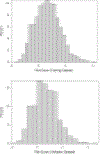Pediatric risk to orthotopic heart transplant (PRO) score: Insights from United Network for Organ Sharing (UNOS) waitlist mortality findings
- PMID: 37439081
- PMCID: PMC10524703
- DOI: 10.1111/petr.14525
Pediatric risk to orthotopic heart transplant (PRO) score: Insights from United Network for Organ Sharing (UNOS) waitlist mortality findings
Abstract
Background: Pediatric heart transplant candidates on the waitlist have the highest mortality rate among all solid organ transplants. A risk score incorporating a candidate's individual risk factors may better predict mortality on the waitlist and optimize organ allocation to the sickest of those awaiting transplant.
Methods: Using the United Network for Organ Sharing (UNOS) database, we evaluated a total of 5542 patients aged 0-18 years old on the waitlist for a single, first time, heart transplant from January 2010 to June 2019. We performed a univariate analysis on two-thirds (N = 3705) of these patients to derive the factors most associated with waitlist mortality or delisting secondary to deterioration within 1 year. Those with a p <0.2 underwent a multivariate analysis and the resulting factors were used to build a prediction model using the Fine-Grey model analysis. This predictive scoring model was then validated on the remaining one-third of the patients (N = 1852).
Results: The Pediatric Risk to OHT (PRO) scoring model utilizes the following unique patient variables: blood type, diagnosis of congenital heart disease, weight, presence of ventilator support, presence of inotropic support, extracorporeal membrane oxygenation (ecmo) status, creatinine level, and region. A higher score indicates an increased risk of mortality. The PRO score had a predictive strength of 0.762 as measured by area under the ROC curve at 1 year.
Conclusion: The PRO score is an improved predictive model with the potential to better assess mortality for patients awaiting heart transplant.
Keywords: pediatric heart transplant; pediatric transplantation; risk factors; solid organ transplantation.
© 2023 The Authors. Pediatric Transplantation published by Wiley Periodicals LLC.
Figures




Comment in
-
Can the pediatric heart transplant waitlist please get more granular?Pediatr Transplant. 2023 Sep;27(6):e14568. doi: 10.1111/petr.14568. Epub 2023 Jul 13. Pediatr Transplant. 2023. PMID: 37439073 No abstract available.
References
-
- Jeewa A, Manlhiot C, Kantor PF, Mital S, McCrindle BW, Dipchand AI. Risk factors for mortality or delisting of patients from the pediatric heart transplant waiting list. J Thorac Cardiovasc Surg 2014;147(1):462–468. - PubMed
-
- Denfield SW, Azeka E, Das B, et al. Pediatric cardiac waitlist mortality-Still too high. Pediatr Transplant Published online March 21, 2020:e13671. - PubMed

